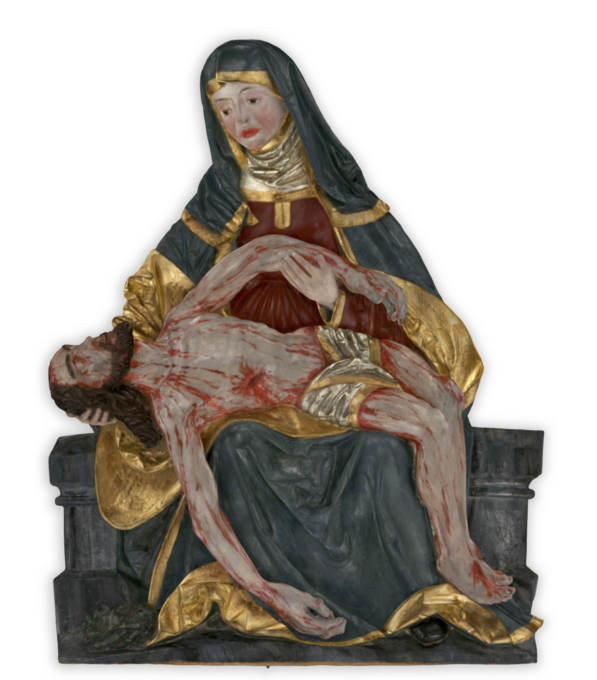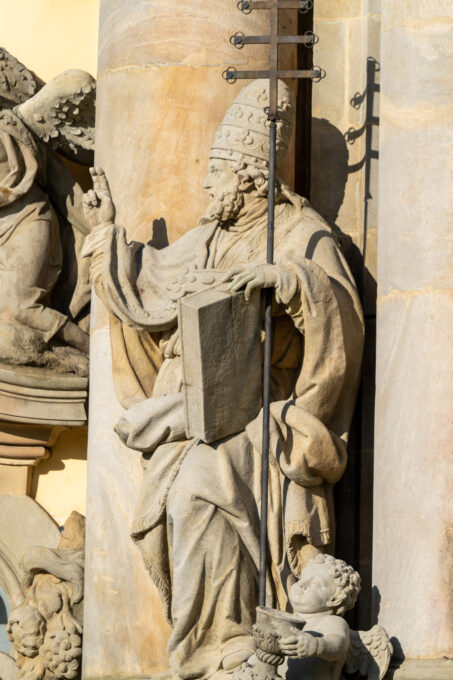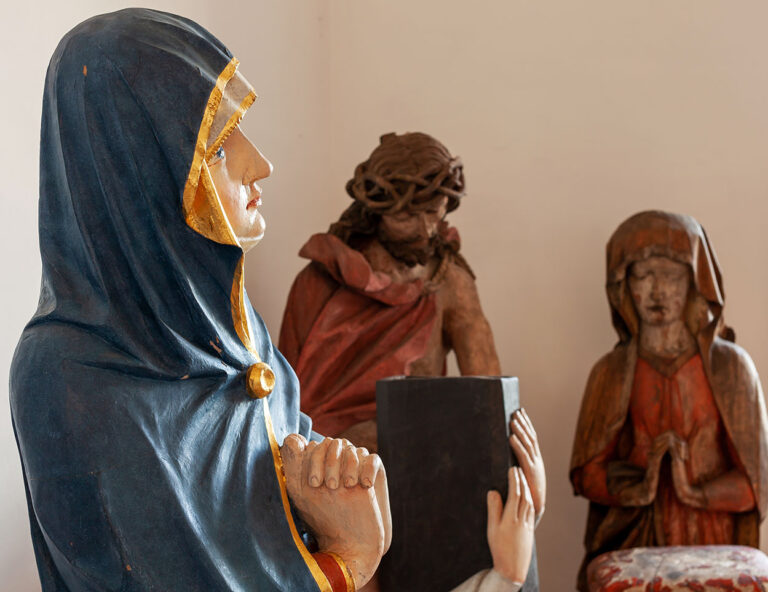Basilica of the Assumption of the Blessed Virgin Mary in Krzeszów
explore
Introduction
House of Grace
of the Mother
of God
Cistercian Abbey in Krzeszów was founded at the end of the 13th century by the Duke of Świdnica and Jawór, Bolko I the Strict. On the 9th of August 1292, 12 monks led by Abbot Theodoric arrived in Krzeszów and occupied the existing buildings. On the 8th of September, the deed of foundation was issued, and the abbey received the title of the Grace of the Holy Mary.
At the end of the 13th century, a monastery and the Abbey Church of St. John the Baptist were built in Krzeszów. The church was intended for the use of monks. Presumably, Duke’s entourage supported Cistercians during construction work. With time, wooden structures began to be replaced by brick buildings which were extended and equipped. Also, work was carried out on construction of new churches around the abbey.
At the beginning of the 16th century, a church whose patron was Christ’s grandmother was built on the nearby St. Anna’s Mountain. Several dozen years later, parish Church of St. Andrew was built there. Abbey’s development peaked in the 17th and 18th centuries when new Baroque churches were erected: the Fraternity Church of St. Joseph, the Abbey Church of the Assumption of the Blessed Virgin Mary and a new monastery. In 1810 Frederick William II issued an edict which brought abbey’s existence to an end.
 gigapanorama
gigapanorama
History
European
Pearl of
Baroque
Basilica of the Assumption of the Blessed Virgin Mary in Krzeszów is one of the most outstanding examples of Silesian Baroque.
In 1727 Innocent Fritsch who had just been elected an Abbot, decided to demolish the Gothic monastery Church of St. John the Baptist. In its place, he planned to build a Baroque church which was supposed to be a Catholic response to the Protestant churches of imperial grace. Its construction began on the 6th of March 1728 and completed 7 years later – on the 3rd of July 1735 when consecration took place.



Employment of the most eminent team of craftsmen and artists allowed the work to be finalised as fast as possible. Apparently 73 bricklayers, carpenters, stonemasons and sculptors were involved. Today we are able to admire a fully completed and impressive result of their joint work.

Part of the history
The history of the Krzeszów Abbey, as well as the creation of the Baroque monastery church, is closely linked to the history of Silesia. It was founded by a Prince from the dynasty of the eldest son of Bolesław Krzywousty – Władysław. The time of the greatest development and construction of a new abbey church called “House of Mary’s Grace” was related to and resulted from the competition between Catholics and Protestants. Eventually, the existence of the monastery came to an end as a result of an edict by Prussian King who closed most of the monasteries in Silesia in 1810.
Facade
of the Minor
Basilica
The portal and the facade face west. The facade is generously decorated with columns, pilasters and sculptures by Ferdinand Brokoff of Prague. The twin towers are covered with copper and their height is 71 metres.
The facade of the church is a creation of great expression and profound theological thought. Its interior consists of three thematic groups: the sculptures of Moses, the saints of Cistercian monastery, also some scenes from the life of the Mother of God and above them six figures symbolising the attributes of Christ: “Admirabilis” (True), “Consiliarius” (Ruler), “Deus” (God), “Fortis” (Strong), “Pater futuri seaculi” (Father of the future century) and “Princeps pacis” (Prince of Peace). On the top of the facade we can admire an impressive group of the Holy Trinity.
Architecture
Roof truss
The roof truss was constructed by 13 carpenters and it was made of oak and fir. Wood was supplied by monastery forests.
The construction of the mansard roof required that none of the beams forming the roof truss should touch the vaults. Therefore, the wooden structure leans against the side walls of the church. In its widest place the roof truss measures 29 metres and it is 80 metres long. According to the regulations back in the day, the monastery Church of the Assumption of the Blessed Virgin Mary was based on a Latin cross plan.



The dimensions of the building are: the main nave (together with the Mausoleum of the Silesian Piast Dynasty and the Chapel of Mary Magdalene) – 118 metres, transept (transverse nave) – 46 metres.
Gold House
for Incarnate
and Born to us
King
Every visitor is amazed by its monumentality and opulent decorations. This piece of work was created by some eminent builders and artists who were also working in other areas such as Czech Republic and Silesia.
The interior is an example of a galleried hall church where we have only one nave and the rows of chapels create an illusion of a three-nave interior. The church is covered with a mansard roof above which there is a fleche (a small turret) exactly above the intersection of the main nave and transept. There are two towers, each 71 metres high. The facade of the church is the so-called “Path of Grace” which consists of three stages and has its source between the towers in the “Throne of Grace”.
 gigapixel
gigapixel
Mausoleum
The Mausoleum
of the Silesian
Piast Dynasty
Behind the main altar of the former monastery Church of the Assumption of Blessed Virgin Mary we find a room which commemorates the founders of the Cistercian Abbey in Krzeszów. It was designed and built as an integral part of the church.
The Mausoleum of the Silesian Piast Dynasty which was completed around 1738, was intended to be a new resting place for Świdnica – Jawór Duke Bolko I the Strict and his successors, including Bolko II the Small. In addition to sarcophagus of the rulers, the room also includes: the tomb of Władysław von Zedlitz, three altars dedicated to All Saints, Wacław and Jadwiga. However, its central part is taken by the epitaph commemorating the legendary Bolko III.
The Organ
Lavishly
decorated
instrument
Abbot Innocent Fritsch (1727-1734) ordered the organs to be made by the famous Wrocław organ builder – Michał Engler (1688-1760) who built 29 such instruments in Czech and Silesia area.
Construction work took him 3 years. On the 8th of December 1736 the instrument was released for liturgical use. The organs were equipped with three manuals, 2606 pipes, 50 registers and 7 box shaped flat bolt windchests for collection of air under the pipes.
Painting
In the footsteps
of Silesian
Rembrandt
The dominant elements in the interior of the church are monumental cycles of frescoes and canvas paintings that are part of subsequent chapels and altars.
The authors in both cases were appreciated baroque painters, including Michael Willmann, known as the “Silesian Rembrandt”, whose two paintings (“12 Sibyls” and “12 Prophets”) hang in the transverse nave.

Nostra
Taumaturga
The miraculous image of Our Lady of Graces with the Krzeszów abbey is probably associated with its entire history.
The icon written (according to legend) by the hermit Krzesz, was lost at the beginning of the 20th century. XV. It was found in 1622 to be placed in the main altar in the 18th century. Nostra Taumaturga [Our Miracle-Worker] is the oldest Marian image in Poland. It shows Mary in the type of hodigitria [showing the way], holding Emmanuel on her right shoulder, making an ambiguous gesture with her other hand – pointing to her son, while keeping her hand on her heart – the source of grace. The performance is dominated by three colors: gold – the symbol of royalty and heaven’s vestibule, red – love, and turquoise – referring to the mystery of the incarnation.
A story
overhead
The vault of the nave is covered with frescoes by Georg Neunhertz. The main idea of these representations is a fragment of the book of the prophet Isaiah.
In consecutive order: The Wonderful, Counselor, God, Mighty, Father of the Future Age, Prince of Peace. Other recognized painters who created in the church in Krzeszów were: F. A. Scheffler, J. Hoffmann and P. Brandl.
Sculpture
The Communion
of Saints
In order to create a large number of sculptures and prepare carved elements, sculpture workshops were created during the process of construction. The vast majority of the works is related to altars and it depicts saints who were important for Cistercians. Baroque sculptures tend to dominate. However, there are some exceptions.
The most famous artists who worked on the Church of the Assumption of the Blessed Virgin Mary are: F.M. Brokoff, his student and later successor A. Dorasil, J. Lachel and I. König.
Key pieces of work include: stalls (seats for monks, by Brokoff, Dorasil) embellished with carvings including apostles and martyrs and a huge organ front (Dorasil) which hides almost 3000 pipes. However, none of their works are considered “the most valuable”. Gothic Pieta from 15th century by an unknown artist is considered as such. It is one of a few examples of the heritage of the medieval Krzeszów Abbey.
 Mary Magdalene at the Cross
3D MODEL
Mary Magdalene at the Cross
3D MODEL
 Lion
3D MODEL
Lion
3D MODEL
 Pieta
3D MODEL
Pieta
3D MODEL
 Our Lady the Helper
3D MODEL
Our Lady the Helper
3D MODEL
 The Sarcophagus of Bolko I Surowy
3D MODEL
The Sarcophagus of Bolko I Surowy
3D MODEL
 Jesus’ trial before Pilate
3D MODEL
Jesus’ trial before Pilate
3D MODEL
 Our Lady at the Cross
3D MODEL
Our Lady at the Cross
3D MODEL
 The Sarcophagus of Bolko II Mały
3D MODEL
The Sarcophagus of Bolko II Mały
3D MODEL
 Christ before Pilate
3D MODEL
Christ before Pilate
3D MODEL
 St. Anne
3D MODEL
St. Anne
3D MODEL
 Sarcophagus of Władysław von Zedlitz
3D MODEL
Sarcophagus of Władysław von Zedlitz
3D MODEL
 Suffering Mary
3D MODEL
Suffering Mary
3D MODEL
 Feretron – The Blessed Virgin Mary
3D MODEL
Feretron – The Blessed Virgin Mary
3D MODEL
 John the Evangelista at the Cross
3D MODEL
John the Evangelista at the Cross
3D MODEL
 Feretron – Baby Jesus
3D MODEL
Feretron – Baby Jesus
3D MODEL
 Christ is placed in the tomb
3D MODEL
Christ is placed in the tomb
3D MODEL
A trace of
the old history
The Baroque Church of the Assumption of the Blessed Virgin Mary took the place of the Gothic monastery Church of St. John the Baptist. Created in 18th century, its lavish furnishings draw attention today but the 15th century Gothic Pieta is the most exceptional.
Craftsmanship
Liturgy setting
Due to the effects of monastic dissolution in the 19th century, a small part of the liturgical objects has remained behind the walls of the post-Cistercian abbey.
Some items from the 17th and 18th centuries which were ordered by the successive Krzeszów Abbots have survived until today. The most exceptional are liturgical objects made for Innocent Fritsch on the occasion of his 50th monastic vows anniversary in 1733. An example of such a gift is the “Emanuel” chalice. Also, an aspersorium which was ordered by Bernard Rosa has been preserved until this day. The other remaining items are mainly candlesticks.
 Monstrancja
gigapixel
Monstrancja
gigapixel

 Świecznik Krzeszów
gigapixel
Świecznik Krzeszów
gigapixel




















 Baroque putto
3D MODEL
Baroque putto
3D MODEL
 The martyrdom of Cistercians of Krzeszów by Hussits
3D MODEL
The martyrdom of Cistercians of Krzeszów by Hussits
3D MODEL
 The night prayer of pilgrims who kneel at the cross
3D MODEL
The night prayer of pilgrims who kneel at the cross
3D MODEL
 The Incense of the Blessed Sacrament
3D MODEL
The Incense of the Blessed Sacrament
3D MODEL
 St. Bernard with apostolic zeal preaches on a tree
3D MODEL
St. Bernard with apostolic zeal preaches on a tree
3D MODEL
 The headstone of the grave of the Weist couple
3D MODEL
The headstone of the grave of the Weist couple
3D MODEL
Promotion of Culture
The project “Digitization of the Historical Monument – Collegiate Church of the former Cistercian Abbey in Krzeszów – Pearls of the European Baroque” received funding from the Ministry of Culture and National Heritage, obtained from subsidies established in games subject to the state monopoly, in accordance with Art. 80 sec. 1 of the Act of November 19, 2009 on gambling.




























































































